Chimie Inorganique
Magnetic and photomagnetic hybrid (nano)materials
Anne Bleuzen (Prof.), Amélie Bordage (Researcher), Giulia Fornasieri (Associate Prof.), Eric Rivière (Research engineer, 20%)
Postdocs : Laura Altenschmidt, Adama N'Diaye
PhD student : Gregory Balthazar
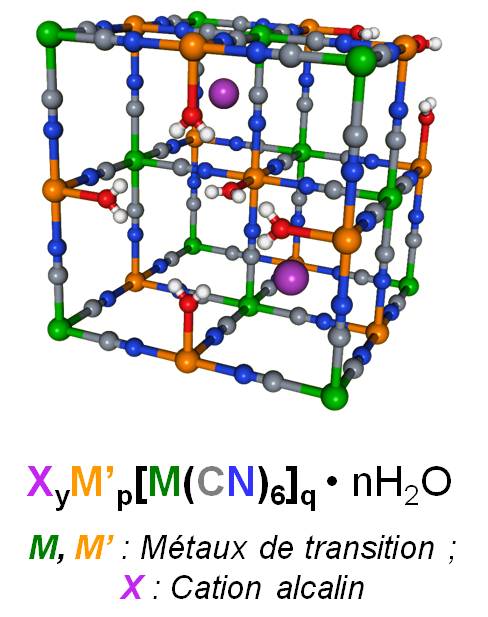
The increasing demand for more efficient data storage devices (increased capacity, faster writing/reading processes,...) requires the elaboration of new bi- or multistable materials. In order to integrate them into real applications, we must be able to synthesize them, control their properties at the nanoscale and organize them in a solid phase.
Prussian Blue analogues (PBAs) are coordination polymers built from a tridimensionnal network of metallic ions bonded by a cyanide linkage. These compounds may present a thermo-, piezzo- or photoinduced metal-metal charge transfer between two electronic states and so with different physical properties. They are thus promising materials for high-density data storage applications.
Moreover, thanks to their versatile and adjustable chemical composition as well as the very fine control of the metallic cations organization in the crystalline structure, they are relevant precursors for the preparation of metallic oxides and alloys by a thermal decomposition under controlled atmosphere. We can thus obtain a very wide range of oxides and alloys with exotic compositions that cannot be achieved through other synthesis routes. Such process can allow the preparation of new original phases with improved bi- or multistable properties.
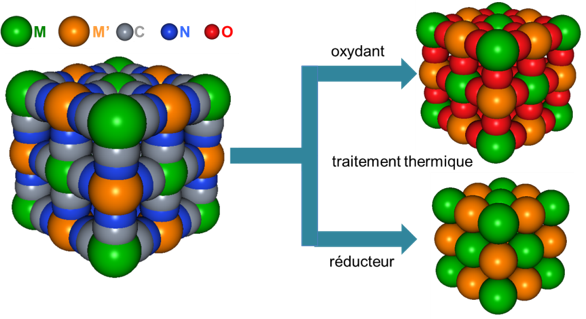
Idealized scheme of the transformation of a PBA into an oxide or an alloy
PBAs are usually obtained as powders. To be able to insert them into applications, it is necessary to control their morphology at the nanoscale during the synthesis process. With the help of a sol-gel process in the presence of structuring agents, it is possible to obtain optically-transparent and chemically-inert matrices with a porosity of well-controlled size and shape. Furthermore, these matrices can also be processed at the macroscale (powders, monoliths, thin films...). We are working on strategies to use this nanostructured oxide porosity as a nanoreactor for i) the synthesis of bi- or multistable nanoparticles and the study of the effects of the processing on the properties (size reduction, confinement effect, interactions with the host matrix...), ii) the synthesis of nanocomposites with new properties originating from the processing (collective behavior of the nanoparticles, anisotropic behaviors caused by their shape and/or their organization, interactive nanocomposites...), and iii) the synthesis of systems enabling the exploration of properties in an application (organization of nanoparticles on a surface or in a matrix).
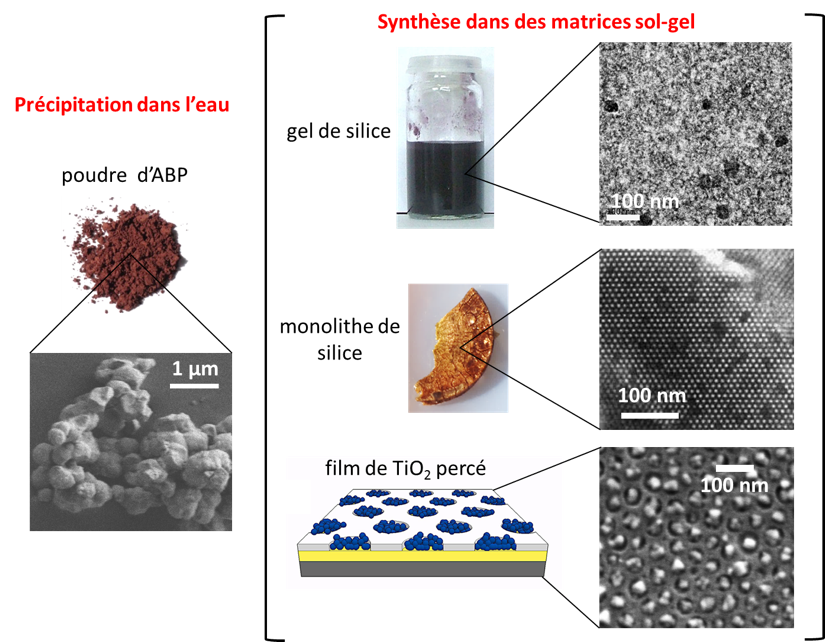
Each study is performed thanks to the coupling between syntheses, laboratory characterizations and synchrotron experiments.
- Laboratory characterizations : powder XRD, IR spectroscopy, BET, TDA-TGA, SQUID magnetometry, SAXS
- Synchrotron experiments : X-ray absorption spectroscopy at the edges of transition metals and alkali cations (experiments at SOLEIL and at ESRF), transition metal K-edge X-ray magnetic circular dichroism (collaboration with the ODE beamline at SOLEIL)
Axis 1 — Elaboration and fundamental study of bi- and multistable systems
Objective: The elaboration of bi- or multistable systems for data storage applications that can be integrated in a real device (i.e. operating at room temperature, chemically and thermally stable,...)
Some CoFe PBAs present a photomagnetic behaviour. At low temperature, they consist in CoIII-NC-FeII diamagnetic pairs. Upon irradiation with visible light, an electron is transferred from the FeII cation to the CoIII cation, leading to the formation of ferrimagnetic CoII-NC-FeIII pairs with a long lifetime at low temperature (T < 100K). The key parameters for such a photomagnetic behavior are known but a deep understanding and a full control of these properties are still lacking. To address this challenge and so use the PBA in real applications, we aim at chemically controlling the relative stability of the states involved in this property and at transfering their working temperature to room temperature.
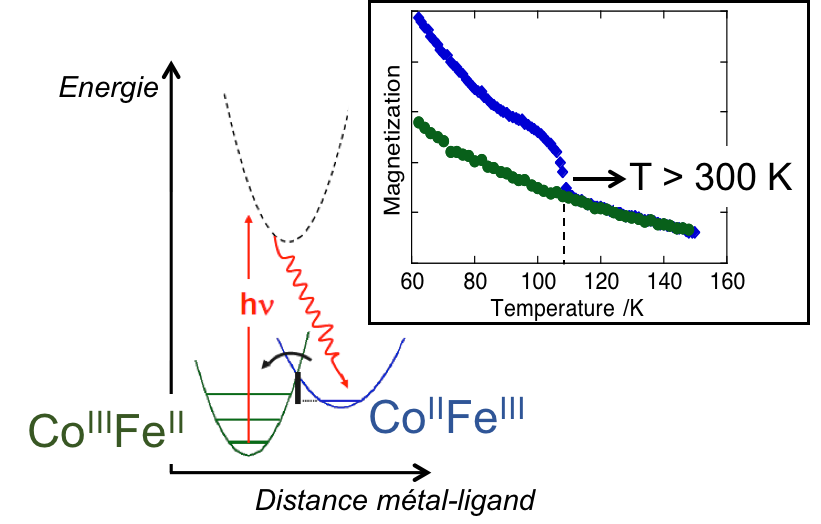
We also use the PBAs as precursors of original oxides and alloys with targeted magnetic, ferroelectric or multiferroic properties. The tuning of the oxide or alloy property can be done through the control of its stoichiometry. A promising route is the calcination of PBAs (in oxidizing or reducing atmosphere), since the stoichiometry of the PBA is perfectly controlled and so is the one of the oxide or alloy after thermal treatment. We optimize the calcination conditions to obtain single-crystalline oxides/alloys phases conserving the stoichiometry of the PBA precursor. In order to better understand the formation of the final phase, we investigate in details the calcination mechanism.
Solid-state magnetic switching triggered by proton-coupled electron-transfer assisted by long-distance proton-alkali cation transport. P. Higel, F. Villain, M. Verdaguer, E. Rivière, A. Bleuzen (2014) J. Am. Chem. Soc. 136, 6231-6234
Room-temperature photo-induced electron transfer in a Prussian blue analogue under hydrostatic pressure. J.-D Cafun, J. Lejeune, F. Baudelet, P. Dumas, J.-P. Itié, A. Bleuzen (2012) Angew. Chem. Int. Ed. 51, 9146-9148
In situ site-selective transition metal K-edge XAS: a powerful probe of the transformation of mixed-valence compounds. A. Bordage, V. Trannoy, O. Proux, H. Vitoux, R. Moulin, A. Bleuzen (2015) Phys. Chem. Chem. Phys. 17, 17260-17265
Axis 2 — Development of oxide matrices elaborated by sol-gel process for the organization of bi- or multustable nanoparticles
Objective : Organizing the bi- or multistable nanoparticles in a solid matrice (with adjustable properties) thanks to the design flexibility offered by the sol-gel process and combined with the use of structuring agents
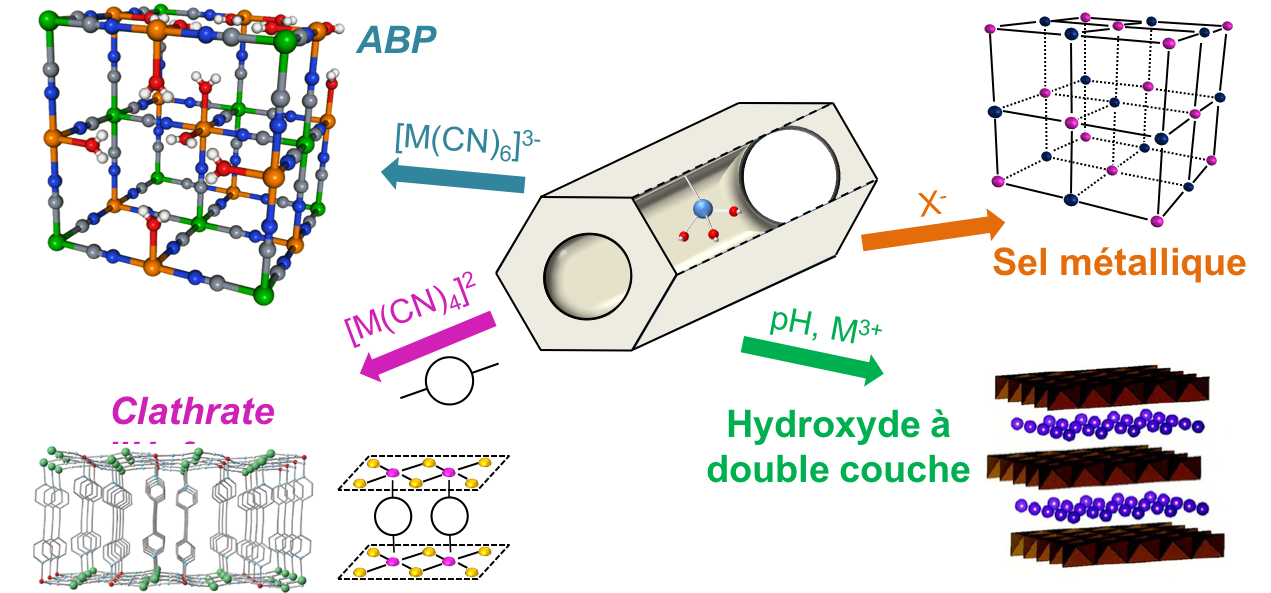
The integration of switchable compounds in real applications requires a processing step. Since the switching properties depend on the size, shape and organization of the functional objects, the control of these parameters and the study of their effects on the properties are a crucial prerequisit to their use in devices. The chemistry of nanostructured oxides enables to obtain optically-transparent and chemically-inert matrices with a porosity whose organization, size and shape are perfectly controlled. These matrices can also be processed at the macroscopic scale (powder, monolith, thin films,...)
We thus want to take advantage of this range of control offered by the sol-gel process for the design of switchable materials. To do so, we develop new strategies using the porosity of nanostructured oxides as reactors for the formation of functional nanoparticles.
Magnetism and photomagnetism of Prussian blue analogue nanoparticles embedded in porous metal oxide ordered nanostructures. G. Fornasieri, A. Bordage, A. Bleuzen (2018) Eur. J. Inorg. Chem. 2018 (3-4), 259-271
Ordered mesoporous silica monolith as a versatile platform for the study of magnetic and photomagnetic Prussian blue analogues nanoparticles. R. Moulin, E. Delahaye, A. Bordage, E. Fonda, J.-P. Baltaze, P. Beaunier, E. Rivière, G. Fornasieri, A. Bleuzen (2017) Eur. J. Inorg. Chem. 2017 (10), 1303-1313
Co2+@mesoporous silica monoliths: tailor made nanoreactors for confined soft chemistry. E. Delahaye, R. Moulin, M. Aouadi, V. Trannoy, P. Beaunier, G. Fornasieri, A. Bleuzen (2015) Chem. Eur. J. 21, 16906-16916
Axis 3 — (Multi)functional nanomaterials
Objective : Using the porosity of sol-gel matrices to study the processing effects, to develop materials with new (photo)magnetic properties and to organize functional nanoparticles at the solid state to exploit their property in a device.
The oxide matrices synthesized via sol-gel processes offer a priceless modularity (organization and size of the porosity, chemical nature of the walls, nature and quantity of the nanoparticles inside the pores,...), which enable to investigate the effects of the nanocomposite processing on the properties of the nanoparticles synthesized in situ.
This nanoporosity can also be organized for large volumes and surfaces. This offers the possibility to i) organize the functional objects and so make them usable in real applications or ii) induce new properties related to the interaction between the objects and/or the shape and organization anisotropy.
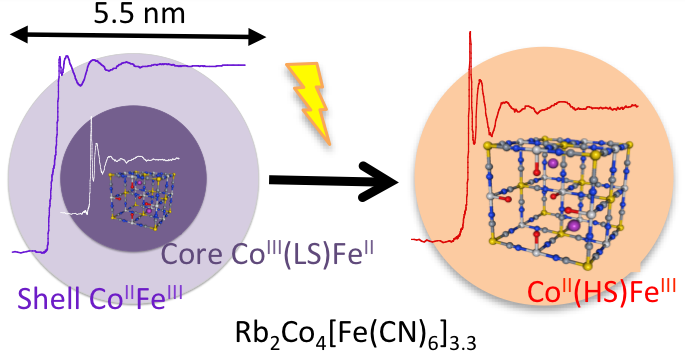
First results showed collective behaviors of the nanoparticles synthesized inside the porosity with original magnetic properties.
Evidence of the core-shell structure of (photo)magnetic CoFe Prussian blue analogue nanoparticles and peculiar behavior of the surface species. A. Bordage, R. Moulin, E. Fonda, G. Fornasieri, E. Rivière, A. Bleuzen (2018) J. Am. Chem. Soc. 140, 10332-10343
Transforming a diamagnetic ordered mesoporous silica monolith into a permanent magnet at room temperature through multi-scale control of the magnetic properties. V. Trannoy, L. Altenschmidt, G. Fornasieri, A. Bordage, E. Rivière, P. Beaunier, A. Bleuzen (2018) (sous presse) ChemNanoMat
Macroscopic magnetic anisotropy induced by the combined control of size, shape and organization of NiFe Prussian blue analog nanoparticles in an ordered mesoporous silica monolith. R. Moulin, G. Fornasieri, M. Impéror-Clerc, E. Rivière, P. Beaunier, A. Bleuzen (2017) ChemNanoMat 3, 833-840
Spatially controlled positioning of coordination polymer nanoparticles onto heterogeneous nanostructured surfaces. V. Trannoy, M. Faustini, D. Grosso, F. Brisset, P. Beaunier, E. Rivière, M. Putero, A. Bleuzen (2017) Nanoscale 9, 5234-5243
Axis 4 — Methodological developments in X-ray absorption spectroscopy
Objective : The development of a new methodology to quantify small structural distortions thanks to the use of PBAs as model compounds
Thanks to their chemical versatility, PBAs offers a wide rage of model compounds particularly interesting for spectroscopic developments. By varying the nature of the transition metals and the inserted alkali cations (number, nature), the electronic and structural parameters can be independently varied. We use this advantage of PBAs to develop a new methodology based on transition metal K-edge X-ray Magnetic Circular Dichroism to quantify small structural distortions.
This project is developped within a collaboration with the ODE beamline at SOLEIL and is funded by an Young Researcher ANR grant.
Investigation of Prussian Blue analogs by XMCD at the K-edge of transition metals. A. Bordage, L. Nataf, F. Baudelet, A. Bleuzen (2016) J. Phys.: Conf. Series 712, 012109
PhD theses
Ongoing
Gregory Balthazar — Effect of size reduction of Prussian Blue analogs particles on their photoswitching properties
PhD advisor : Anne Bleuzen ; Co-advisor : Giulia Fornasieri (Started in october 2020)
Defended
Adama N'Diaye — XMCD at the K-edge of transition metals and Prussian Blue Analogs : A new approach for the understandng of the signals (2022)
PhD advisor : Anne Bleuzen ; Co-advisor : Amélie Bordage
Laura Altenschmidt — Assemblies of magnetic nanoparticles for the development of materials with new properties (2021)
PhD advisor : Anne Bleuzen ; Co-advisor : Giulia Fornasieri
Robinson Moulin — Mesoporous silica matices for developping multifunctional nanomaterials (2016)
PhD advisor : Anne Bleuzen
Virgile Trannoy — Towards the elaboration of recordable magnetic track : From the molecule to the material (2015)
PhD advisor : Anne Bleuzen
Julien Lejeune — Switching properties of CoFe Prussian blue analogues : Towards a control of the position in terms of energy of the stable and metastable states (2013)
PhD advisor : Anne Bleuzen
Last publications (2016 - Today)
Orbital magnetic moment and single-ion magnetic anisotropy of the S=1/2 K3[FeIII(CN)6] compound. M. Retegan, S. F. Jafri, L. Curti, L. Lisnard, E. Otero, E. Rivière, M. W. Haverkort, A. Bleuzen, P. Sainctavit, M.-A. Arrio, Inorganic Chemistry, 2023, 62, 18864-18877
A Peculiar Photo-Induced Transformation Exalted in Nanometric Size CoFe Prussian Blue Analogs. G. Balthazar, A. Bordage, G. Fornasieri, L. Altenschmidt, A. Zitolo, A. Bleuzen, ChemPhotoChem, 2023, 7, e202300102
Iron ions embedded in hexagonal mesoporous silica via a simple method: implementation in mild oxidation catalysis. R. Guemati, J.-N. Rebilly, G. Fornasieri, D. Dragoe, S. Biswas, F. Banse, A. Bleuzen, ChemistrySelect, 2023, 8, e202302150
Simple fabrication of e-Fe2O3 nanoparticles containing silica monoliths with enhanced coercitivity. L. Altenschmidt, P. Beaunier, A. Bordage, E. Rivière, G. Fornasieri, A. Bleuzen, ChemNanoMat, 2023, 9, e202200469
Towards quantitative magnetic information from transition metal K-edge XMCD of Prussian Blue analogs. A. N'Diaye, A. Bordage, L. Nataf, F. Baudelet, E. Rivière, A. Bleuzen, Inorganic Chemistry, 2022, 61, 6326-6336
Prussian Blue analogs and transition metal K-edge XMCD: A longstanding friendship. A. Bordage, A. N'Diaye, A. Bleuzen, Comptes Rendus Chimie, 2022, 25, 281-288
Interplay between transition metal K-edge XMCD and magnetism in Prussian Blue analogs. A. N'Diaye, A. Bordage, L. Nataf, F. Baudelet, E. Rivière, A. Bleuzen, ACS Omega, 2022, 7, 36366-36378
Co, Fe and CoFe oxide nanoparticle assemblies within an ordered silica matrix: effects of the metal ions and synthesis pathway on the microstructure and magnetic properties. L. Altenschmidt, P. Beaunier, E. Riviére, G. Fornasieri, A. Bordage, A. Bleuzen, The European Physical Journal Special Topics, 2022
A cookbook for the investigation of coordination polymers by transition metal K-edge XMCD. A. N’Diaye, A. Bordage, L. Nataf, F. Baudelet, T. Moreno, A. Bleuzen, Journal of Synchrotron Radiation, 2021, 28, 1127-1136
One-pot prepared mesoporous silica SBA-15-like monoliths with embedded Ni particles as selective and stable catalysts for methane dry reforming. O. Daoura, G. Fornasieri, M. Boutros, N. El Hassan, P. Beaunier, C. Thomas, M. Selmane, A. Miche, C. Sassoye, O. Ersen, W. Baaziz, P. Massiani, A. Bleuzen, F. Launay, Applied Catalysis B: Environmental, 2021, 280, 119417
Influence of the number of alkali cation on the photo-induced CoIIIFeII-CoIIFeIII charge transfer in CsxCoFe PBAs - A Co K-edgeXANES study. A. Bordage, A. Bleuzen, Radiation Physics and Chemistry, 2020, 175, 108143
(Photo)magnetism in 5 nm nanocrystals of the alkali cation free-CoFe prussian blue analogue embeddedin a silica matrix. A. Bleuzen, M. Goncalves, L. Altenschmidt, G. Fornasieri, A. Bordage, E. Rivière, Chemistry Squared, 2020, 4, 1
Forty years of exchange interactions on the occasion of the 75th birthday of Michel Verdaguer. A. Bleuzen, V. Marvaud, C. Train, Comptes Rendus Chimie, 2019, 22, 435-436
Toutes les couleurs du bleu de Prusse. G. Fornasieri, A. Bleuzen, L'Actualité chimique, 2019, 444-445, 16-21
Effect of alkali cations on the photomagnetic behavior of CoFe Prussian blue analogue nanoparticles embedded in ordered mesoporous silica. L. Altenschmidt, G. Fornasieri, E. Rivière, F. Brisset, R. Saint-Martin, A. Bleuzen, Comptes Rendus Chimie, 2019, 22, 508-515
Towards the synthesis of mixed oxides with controlled stoichiometry from Prussian blue analogues. V. Trannoy, A. Bordage, J. Dezalay, R. Saint-Martin, E. Rivière, P. Beaunier, C. Baumier, C. La Fontaine, G. Fornasieri, A. Bleuzen, CrystEngComm, 2019, 21, 3634-3643
Transforming a Diamagnetic Ordered Mesoporous Silica Monolith into a Room Temperature Permanent Magnet through Multiscale Control of the Magnetic Properties. V. Trannoy, L. Altenschmidt, G. Fornasieri, A. Bordage, E. Rivière, P. Beaunier, A. Bleuzen, ChemNanoMat, 2018, 4, 1254-1261
Epsilon-Fe2O3 Nanocrystals inside Mesoporous Silicas with Tailored Morphologies of Rod, Platelet and Donut. J.-G. Li, G. Fornasieri, A. Bleuzen, M. Gich, M. Impéror-Clerc, ChemNanoMat, 2018, 4, 1168-1176
Weak Ferromagnetic Interaction at the Surface of the Ferrimagnetic Rb2Co4[Fe(CN)6]3.3·11H2O Photoexcited State. S. Jafri, M.-A. Arrio, A. Bordage, R. Moulin, A. Juhin, C. Cartier Dit Moulin, E. Otero, P. Ohresser, A. Bleuzen, P. Sainctavit, Inorg. Chem., 2018, 57, 7610-7619
Evidence of the Core–Shell Structure of (Photo)magnetic CoFe Prussian Blue Analogue Nanoparticles and Peculiar Behavior of the Surface Species. A. Bordage, R. Moulin, E. Fonda, G. Fornasieri, E. Rivière, A. Bleuzen, J. Am. Chem. Soc., 2018, 140, 10332-10343
Magnetism and Photomagnetism of Prussian Blue Analogue Nanoparticles Embedded in Porous Metal Oxide Ordered Nanostructures. G. Fornasieri, A. Bordage, A. Bleuzen, European Journal of Inorganic Chemistry, 2018, 3-4, 259-271
Effect of S on the aqueous and gaseous transport of Cu in porphyry and epithermal systems: Constraints from in situ XAS measurements up to 600°C and 300bars. M. Louvel, A. Bordage, B. Tripoli, D. Testemale, J.-L. Hazemann, J. Mavrogenes, Chemical Geology, 2017, 466, 500-511
Macroscopic Magnetic Anisotropy Induced by the Combined Control of Size, Shape and Organization of NiFe Prussian Blue Analog Nanoparticles in an Ordered Mesoporous Silica Monolith. R. Moulin, G. Fornasieri, M. Impéror‐clerc, E. Rivière, P. Beaunier, A. Bleuzen, ChemNanoMat, 2017, 3, 833-840
Preserving the spin transition properties of iron-triazole coordination polymers within silica-based nanocomposites. H. Voisin, C. Aime, A. Vallee, A. Bleuzen, M. Schmutz, G. Mosser, T. Coradin, C. Roux, J. Mater. Chem. C, 2017, 5, 11542-11550
Spatially controlled positioning of coordination polymer nanoparticles onto heterogeneous nanostructured surfaces. V. Trannoy, M. Faustini, D. Grosso, F. Brisset, P. Beaunier, E. Riviere, M. Putero, A. Bleuzen, Nanoscale, 2017, 9, 5234-5243
Temperature dependence of X-ray absorption and nuclear magnetic resonance spectra: probing quantum vibrations of light elements in oxides. R. Nemausat, C. Gervais, C. Brouder, N. Trcera, A. Bordage, C. Coelho-Diogo, P. Florian, A. Rakhmatullin, I. Errea, L. Paulatto, M. Lazzeri, D. Cabaret, Phys. Chem. Chem. Phys., 2017, 19, 6246-6256
Ordered Mesoporous Silica Monoliths as a Versatile Platform for the Study of Magnetic and Photomagnetic Prussian Blue Analogue Nanoparticles. R. Moulin, E. Delahaye, A. Bordage, E. Fonda, J.-P. Baltaze, P. Beaunier, E. Rivière, G. Fornasieri, A. Bleuzen, European Journal of Inorganic Chemistry, 2017, 2017, 1303-1313
Alignment under Magnetic Field of Mixed Fe2O3/SiO2 Colloidal Mesoporous Particles Induced by Shape Anisotropy. J.-G. Li, G. Fornasieri, A. Bleuzen, M. Gich, A. Gloter, F. Bouquet, M. Impéror-Clerc, Small, 2016, 12, 5981-5988
Investigation of Prussian Blue Analogs by XMCD at the K-edge of transition metals. A. Bordage, L. Nataf, F. Baudelet, A. Bleuzen, Journal of Physics: Conference Series, 2016, 712, 012109
Last update on Feb. 25th 2022

